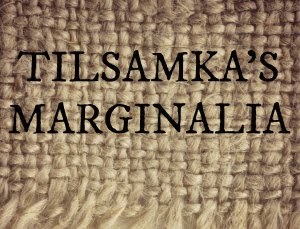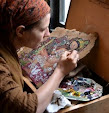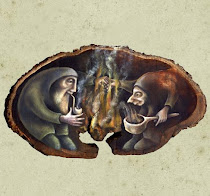
UNDERNEATH our feet and underneath our eyelids and underneath the dead leaves of last year something has been happening. It came tentatively at first: shyly stepping in, still wrapped in a cloudwool scarf that it might still need. And at its knock, we got up out of our deadwood armchairs and stretched our stiffened arms in the sun.
Morning walks amongst the trees have breathed warm green into us. And the birds have sung us their heart-bursting songs of New. Always always at the turning of a new season I am reminded of all the others I have lived through. Glimpses like scents of previous Springs float past, and I am thrilled by the trilling of the birds who are glad and agree in my bones that things are warming.
There was a point near Spring's beginning, though, when the year's wheel hesitated; it got stuck in a rut in the road. The eager early blooming flowers were surprised by late frosts - we saw ice-edged daffodils hanging their heads in sheepish dismay. The first bursts of our own new-found energy for work and ventures got blocked too in the juddering starting of the engine of the year, and wilted like frost-bitten petals, bloomed-too-soon.
Even down in the water on the common there was a hiccup where day by day as we walked by we'd watched the black specks in their frogspawn jelly morph gradually into tadpoles. When the late cold came the water froze over and trapped within its icy crust a good many little swimmers who had been wriggling trustingly toward froghood, now halted forever in their growing.




I broke the ice for them: a cold photographic slide depicting their frozen moment of death - never-to-be-frogs encased in a beautiful snapshot of air bubbles and green green pondweed.
There was even still some unhatched frogspawn, which had been iced too, but underneath the ice their brothers swam on.


Not until I got home and opened up these photographs did I notice their little brown mouths and pinprick eyes and minuscule handlike frondlike gills, which in time they will reabsorb along with their tails, and hop out of the water in their new amphibious costumes. For now, the water is a mass of brown wriggling.

When the days were still grey, we went out to Wistman's Wood again, and sat amongst the elphame trees and green rocks there, stunned as I think I always will be in that place, by its beautiful strangeness. As we were about to leave, we glimpsed wild Dartmoor ponies at the top edge of the woods.






They were not scared as we approached, and continued to nibble (moss perhaps) from the tips of the branches. Dartmoor's umbers and greys and mosses made a wild and quiet backdrop for their chestnuts and whites and coppers. And dappled on the hill they gently walked and chewed as the valley stretched on below them and we went home.


But after a false start, Spring returned in earnest a few weeks ago. The days lately have been celebrations of sunshine and even pigeons sing in the mornings now. We have walked in the trees where the light paints the moss on their trunks brighter than it has been for nearly a year.



I stand with the sun on my back and the young trees stretch up with purpose and hum in that light which could only come through the branches in March. As we walk through the trees, it is warm enough to stop, and to sit amongst them listening to their hopes for the day and the sound of a slight smile in their voices.


 Everywhere is bursting out: shoots and buds and openings occupy all quarters. New growth emerges from the elbow in a thorny stem; trees send forth their green spears; new buds grow on branches where old leaves still cling.
Everywhere is bursting out: shoots and buds and openings occupy all quarters. New growth emerges from the elbow in a thorny stem; trees send forth their green spears; new buds grow on branches where old leaves still cling.

Through the dead carpet green bursts regardless. Here at this still moment we see life turning; we see life-in-death and know also that Death is always there, hands held in the merry dance with Life, skipping in a circle underneath our every moment.
A dead fox appears on our path one morning, mysteriously flung there by the roots of a tree, no sign of a fight, perhaps a bullet hole in amongst its still beautiful fur.




And days later Tom discovers a whole cow rotted to bones. We return that evening with rucksacks to collect, and marvel at the heavy bulk of the pelvis and the great skull full of herbivore's teeth. The vertebrae make a ladder in the grass, the tail tip is a witch's finger and the leg bones weigh heavy as a log.

How long this cow has been here, we don't know. The lower jawbone is elusive, and the other bones are scattered wide. We ponder the cow's demise whilst imagining the bones hung in the trees as eerie wind-chimes for the evening.

And then the celandines begin singing, awake and happy and holding dew on their yellow tongues. The waysides are stirring green again: a wild larder and my favourite of all gardens.
All through this Spring, we've dreamt and worked and laughed and walked. There was a House-that-Wasn't and a House-that-Will-Be. There has been sky gazing and hound running and vegetable dreaming and equinox celebrating. But that is all I'll say for now...


Branches against dusk skies made a labyrinth of fingers, filigree as the blood vessels on the back of your eye, and the clock on the churchtower chimes now over daffodils as yellow as bright as the promised sun, and yellow as the tune on my lips.










































































